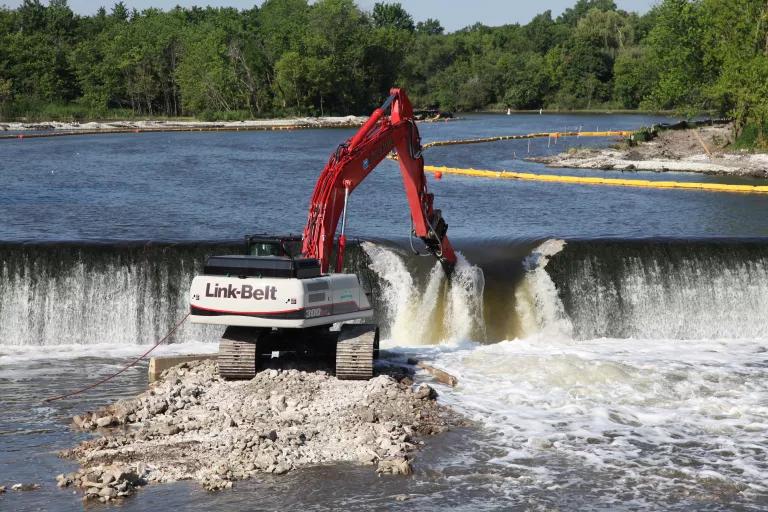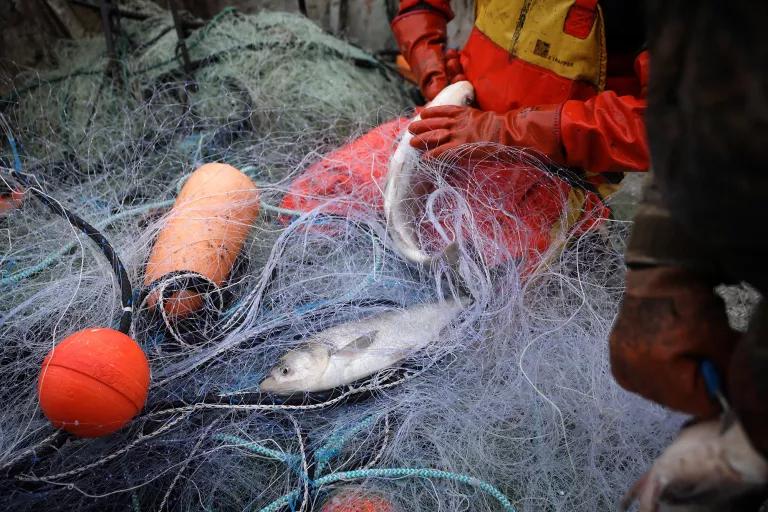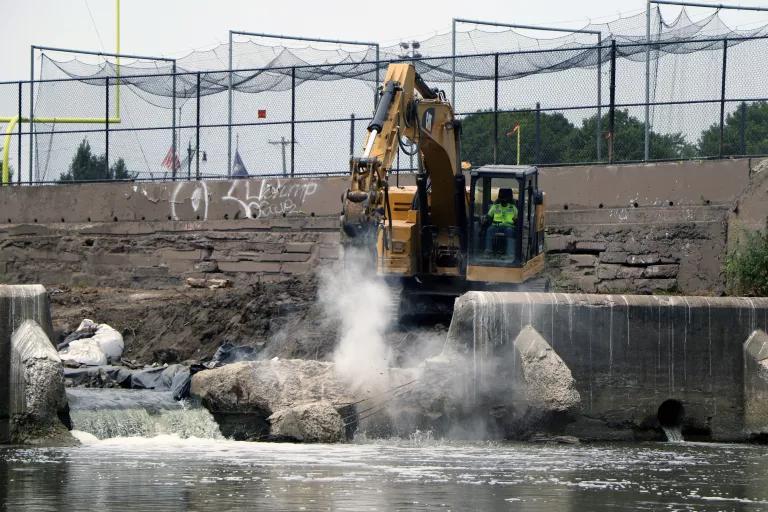After a Century of Being Dammed Up, Illinois Rivers Get to Go With the Flow
Dam removals are setting rapids and fish populations free and keeping swimmers and boaters safer.

Dam removal has allowed more than 100 miles of Illinois rivers to flow freely for the first time in decades.
Marianne Morgan/InIllinoisWater.org
When a rainstorm in March swelled the Chicago River, Matt Renfree and Jason Steger set out to do something they’d always wanted to do but couldn’t: shoot the river’s rapids.
The two friends took a 17-foot Old Town Tripper canoe to the river’s North Branch, just a few miles from downtown Chicago and where, until last September, a 4-foot dam had stood. Then they zipped over 100 yards of whitewater, climbed out, and walked back to the launch site to ride down again and again. It had been 78 years since anyone had ridden these rapids, which the canoers classified as “class 2 to 2-plus,” and it was awesome, says Renfree.
Of course, paddlers aren’t the only ones who stand to benefit from the newly gushing waters. According to researchers, removing dams can restore river habitats and make waterways safer for swimmers. Smallmouth bass, suckers, and channel catfish benefit from dam removals, as do rare or endangered freshwater mussels, whose larvae move upriver by hitching a ride on fish once a dam is gone. These species are now rebounding following the removal of the dam on the North Branch and some 16 others taken down in Illinois in the past five years. The effort reflects a national trend as these structures, which harm ecosystems and prevent rivers from flowing freely (often for no reason), are dismantled.

The removal of Hofmann Dam along the Des Plaines River in 2012
Jessica Majchrowski/U.S. Army Corps of Engineers
Stream specialists studied rivers like the Fox and the Des Plaines before and after the dam removals and found that the number of fish species increased by 6 percent in just one year. In most cases the effects are “almost immediate,” says Steve Pescitelli, a fisheries biologist for the state’s Department of Natural Resources who conducts surveys on rivers in northeastern Illinois. That’s because without the dams in their way, the fish can move from one stretch of river to another and access more spawning habitats. Most freshwater fish aren’t strong swimmers, compared with, say, salmon, which migrate between ocean and river habitats, but “they do move around more than people think,” says Pescitelli.
One downside to demolishing dams in some places: It can give invasive fish like Asian carp the chance to infest new territories. At least one dam removal in Illinois was taken off the table due to fears that this voracious fish could plague new stretches of river. But the pros of dam removal often outweigh the cons, and in areas of concern, state officials keep careful watch for any potential invaders.

Seth Love, a fisheries biologist with the Illinois Department of Natural Resources, sorting Asian carp in an inlet of the Illinois River near Starved Rock in 2018
E. Jason Wambsgans/Chicago Tribune via Alamy Live News
The removals are the result of work by scientists and nonprofits such as American Rivers, a national organization that launched its dam-busting campaign decades ago, and local groups like the Forest Preserves of Cook County and Friends of the Chicago River, which took up the cause in 2012. That’s when then-governor Pat Quinn announced an effort to get rid of low-head dams, structures that rise one to three feet out of the water.
Big projects, like the 2011–2014 dam removal on Washington’s Elwha River, the largest such project in U.S. history, and the demolition of the Bloede Dam on Maryland’s Patapsco River, get a lot of press. But even teardowns that don’t require tons of dynamite can have dramatic results.
Damning Evidence
After a century of damming, deepening, and straightening meandering rivers, hydrologists, aquatic ecologists, and ichthyologists have become more aware of just how much damage dams inflict on riverine ecosystems and the people who enjoy them.
Public safety is a big reason why state and local officials have pushed to rid their waterways of dams, especially low-head dams. As water perpetually pours over these structures, it forms a circular current that pulls swimmers or boaters under and back toward the dam. Thousands of these low-profile dams currently span American rivers, and though no national statistics exist on how many people drown near them, 18 people have died in the past 25 years near a single dam on the Fox River. After nearly dying himself while trying to save a drowning teenager near one of these so-called drowning machines, one Ohio firefighter described the current: “It’s like being caught by a monster. It just won’t let you go.”
In addition to human lives and fish populations, dams also take a toll on water quality by slowing a river’s flow. This allows sediments (suspended dirt and clay particles) to sink to the bottom, blanketing habitat and burying fish food. Slower currents also reduce the amount of oxygen that mixes into the water, a crucial component to fish and insect survival. When turbulent water rushes over riffles and rocks, oxygen aerates the river; when water is sluggish, it does not. Nutrients like phosphorus can also collect behind dams and cause algae to bloom, further depleting the amount of available oxygen.
Dam removal advocates point out that most of the Illinois dams taken out or slated for demolition no longer serve their original purpose anyway—which in some cases was to help farmers cross rivers before local bridges went up. In the early 1900s, when sewage treatment was not yet widely adopted, many communities still dumped their waste right into the river. Dams and the deeper waters that pooled behind them could keep odors from wafting into the air. But in the summertime, when warmer temperatures led to more evaporation, water levels would fall and expose riverbanks caked in refuse.
Without dams, not only are rivers safer and healthier, but they also come one step closer to being fishable and swimmable, a requirement under the Clean Water Act. Pescitelli says, “Rivers have intrinsic value, which is often the hardest thing to articulate, but by law we have to clean up these streams, and dams are an important part of that equation.”
Downstream Effects
The Fox River is a slow-moving prairie river that ambles 202 miles from Waukesha, Wisconsin, to Ottawa, Illinois. Along 115 of those miles flowing through the Prairie State, however, the Fox River is segmented by 15 dams. In the mid-1800s, when the dams first went in, people would cut and store the ice that formed behind the structures (much like in the movie Frozen, the nonprofit Friends of the Fox River points out).
The dams had their benefits, but now, more than a century later, their negative effects are apparent. In 2003, Pescitelli and others looked at the environmental impacts of the 15 dams individually and found that the water quality above each one was much worse than in the free-flowing sections. Also, as a whole, the dams negatively affected fish distribution.
That study helped make an environmental case for dam demolitions all over the state. Two structures along the Fox came out. Nine were removed along the Des Plaines, which flows through Chicago’s western suburbs, allowing more than 100 miles of river to flow freely for the first time in decades.
The Illinois Department of Natural Resources (IDNR) tore down another dam on the Vermilion River last year, and in March a construction company hired by IDNR began jackhammering the Ellsworth Park Dam on the North Fork of the Vermilion. Without the two dams, 175 miles of river will flow unobstructed, and researchers expect notable improvements to habitat and fish populations there, says Trent Thomas, an IDNR fisheries biologist. Since the first dam on the Vermilion River was removed last year, researchers from Eastern Illinois University have already spotted a sturgeon, an ancient fish never before seen in that stretch of river. Native mussels and their hitchhiking young could also rebound. Even fish that historically migrated north from the Gulf of Mexico, like American eels, could return.

Demolition of the North Branch Dam near the North Branch of the Chicago River and the North Shore Channel River in 2018
Elizabeth Concepcion/U.S. Army Corps of Engineers
Though dam removals in Illinois have slowed in recent years due to state budget constraints, at least three more on the Des Plaines await demolition permits.
In the meantime, recreation on the state’s rivers is rebounding too. This summer on the North Branch, for instance, the Chicago Park District is offering events for moonlight paddling and botanizing by boat near the place where Renfree and Steger rode the rapids in March. Boaters might even see some coho salmon spawning here in the fall, something Renfree witnessed last year.
“Historically, the city has used the river as a sewer,” Renfree says; not many people look at the river and “see that it’s a living, breathing waterway with a whole ecosystem.” One day, he hopes not too far in the future, that perspective will just be water over the dam.
This NRDC.org story is available for online republication by news media outlets or nonprofits under these conditions: The writer(s) must be credited with a byline; you must note prominently that the story was originally published by NRDC.org and link to the original; the story cannot be edited (beyond simple things such as grammar); you can’t resell the story in any form or grant republishing rights to other outlets; you can’t republish our material wholesale or automatically—you need to select stories individually; you can’t republish the photos or graphics on our site without specific permission; you should drop us a note to let us know when you’ve used one of our stories.

The Big Muddy River’s Long, Turbulent Relationship with Coal
Can We Save the Midwest’s Only Rattlesnake?
How Fish Autopsies Help in the Fight Against the Invasive Asian Carp